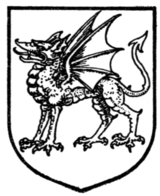will be found ending in a barb, but it should be observed that this is a comparatively recent addition. All dragons of the Tudor period were invariably represented without any such additions to their tails. The tail was long and smooth, ending in a blunt point.
Whilst we have separate and distinct names for many varieties of dragon-like creatures, other countries in their use of the word "dragon" include the wyvern, basilisk, cockatrice, and other similar creatures, but the distinct name in German heraldry for our four-footed dragon is the Lindwurm, and Fig. 427 is a representation of the dragon according to German ideas, which nevertheless might form an example for English artists to copy, except that we very seldom represent ours as coward.
 Fig. 424.—Dragon rampant. |
 Fig. 425.—Dragon passant. |
 Fig. 426.—Dragon statant. |
The red dragon upon a mount vert, which forms a part of the Royal achievement as the badge of Wales, is known as the red dragon of Cadwallader, and in deference to a loudly expressed sentiment on the subject, His Majesty the King has recently added the Welsh dragon differenced by a label of three points argent as an additional badge to the achievement of His Royal Highness the Prince of Wales. The red dragon was one of the supporters of the Tudor kings, being used by Henry VII., Henry VIII., and Edward VI. Queen Elizabeth, however, whose liking for gold is evidenced by her changing the Royal mantle from gules and ermine to gold and ermine, also changed the colour of the dragon as her supporter to gold, and many Welsh scholars hold that the ruddy dragon of Wales was and should be of ruddy gold and not of gules. There is some room for doubt whether the dragon in the Royal Arms was really of Welsh origin. The point was discussed at some length by the present writer

